Grace Elliot's Blog: 'Familiar Felines.' , page 9
September 30, 2014
The Medieval Midwife: Guest post by Kim Rendfeld
Today I'm delighted to welcome Kim Rendfeld to "Fall in Love with History". Kim writes historical fiction and is celebrating a new release "The Ashes of Heaven's Pillar", which I have added to my TBR pile! Today, Kim posts on "The Medieval Midwife’s Unique Place in Society", so without further ado I'll hand over to Kim G x
The Medieval Midwife’s Unique Place in Society
By Kim Rendfeld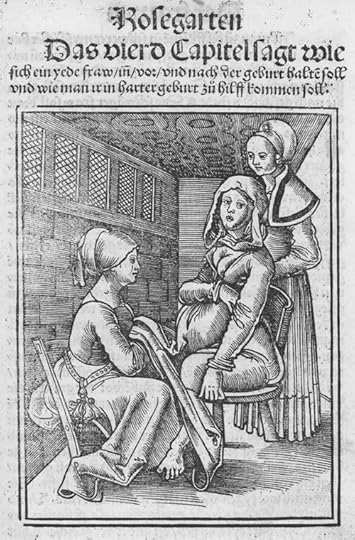
The medieval midwife faced a lot of pressure. Not only was she to do her best to help mother and baby survive the birth. As the only layperson with the authority to baptize, she was responsible for the newborn’s soul.
In the Middle Ages, childbirth must have been greeted with a mix of emotions. A family might look forward to the arrival of an heir, but the process was so risky that women were urged to confess their sins before they went into labor.
Whether the delivery was in a low-ceilinged lying-in chamber of a noble house or a one-room peasant’s hut, the last person an expectant mother wanted was her husband or a doctor. Medieval folk considered childbirth part of life, not medicine. Better for the men to be praying at church and let the midwife take charge of the situation.
A midwife learned her craft from her own mother. Her tools might include a birthing stool, a sharp knife, ointments, herbs, the right foot of a crane, a piece of jasper, spells in case the labor was particularly difficult, a basin to bathe the baby, honey, and salt. The Church did not condemn the midwife for touching another woman in an intimate area, since her duties required it.
Officially, the clergy frowned on spells and charms, but as they did with most other white magic, they ignored it for the most part. Medieval folk in general saw magic as a tool, one that could be used for good or evil. After all, the laity often wore amulets alongside their crosses. Clerics were much more concerned if the midwife said the wrong words while baptizing a child in danger of dying before a priest could perform the rite.
Inside the birthing chamber, the midwife had her own assistants, and a few of the mother’s friends and relatives attended to offer encouragement. Doors and cupboard drawers were open; knots were untied. Even the mother’s hair might be loosened and free of pins.
The midwife would do what she could to hasten labor, such as rubbing an ointment on the mother’s belly or giving her a potion with ergot. When the time came, the mother would sit on the birthing stool to deliver the child. Midwives knew to wash and oil their hands before they brought the child into the world. The only time a midwife would perform a Caesarean, without anesthesia, was when the mother was dying or already dead.
The midwife was the one to cut the umbilical cord four finger lengths, wash the baby, and use honey on the child’s gums and palette to stimulate appetite. After the infant was wrapped in swaddling, the midwife would present the child to the father.
In noble houses, the mother would remain confined to the lying-in chamber for a month, and only the midwife, servants, and the mother’s close friends were allowed to visit during her recovery.
I needed to research medieval childbirth for two scenes in my latest release, The Ashes of Heaven’s Pillar. One goes reasonably well; the other goes very, very wrong. In this scene, Sunwynn, the daughter of my heroine, Leova, is the maid to the expectant mother. Both Sunwynn’s and Leova’s well-being depend on the well-being of Countess Gerhilda. Click for a link
Click for a link
Excerpt:
When Gerhilda screamed and doubled over, the midwife rushed to her. The old woman lifted Gerhilda’s skirts and felt her belly. “The child is coming,” she called. “Get her to the birthing stool.”
The midwife washed and oiled her hands and sat on a stool in front of Gerhilda, whose skirts were hiked to her waist.
“I’m here, my lady. Behind you,” Sunwynn whispered.
At Sunwynn’s elbow, one of the midwife’s assistants held a cup smelling of strong wine.
“Ergot?” the midwife asked her assistant. “Good. My lady, drink the potion. It will hasten the birth and might stop the bleeding.”
As Gerhilda downed the wine, Sunwynn prayed, Mother of God, let this work.
The midwife reached for Gerhilda. The grim lines in her face deepened. “Afterbirth’s first.”
The room was silent except for Gerhilda’s grunts. Sunwynn’s limbs grew rigid. She felt her mother’s hand on her shoulder.
“I have the child,” the midwife said. When she leaned back, blood covered her arms and chest. She cradled a listless newborn and the afterbirth.
“Another son,” the midwife said in a monotone.
“Good,” Gerhilda whispered.
The babe is not crying! Sunwynn stared at the infant. He was quiet when the midwife wiped his nose and mouth. A slap to the bottom was met with barely a whimper. Sunwynn winced. A few other women groaned.
“Daughter, hold the jasper amulet to the countess’s belly until it’s warm,” the midwife told an assistant.
The midwife cut the cord and placed the child in the basin she used to wash her hands. Three times, she used her cupped hand to pour water on the child’s head and muttered a Latin prayer. Sunwynn shuddered. There was only one reason a midwife would baptize a newborn.
Sunwynn beheld her lady’s face. It was paler than anything she had ever seen.
“Pray for me; pray for my son,” Gerhilda mumbled. Her eyes rolled, and she swooned, slumping forward.
“Gerhilda!” Sunwynn shrieked, shaking her lady’s shoulders. “Gerhilda! No! Come back! Come back and live!” Sunwynn, her tears unchecked, looked at the midwife.
Sources:
Daily Life in Medieval Times by Frances and Joseph Gies
Europe after Rome: A New Cultural History 500-1000 by Julia M.H. Smith
“Capturing the Wandering Womb” by Kate Phillips, The Haverford Journal, April 2007 Author: Kim Rendfeld
Author: Kim Rendfeld
Kim Rendfeld is the author of The Cross and the Dragon (2012, Fireship Press) and The Ashes of Heaven’s Pillar (August 28, 2014, Fireship Press). To read the first chapters of either novel or learn more about Kim, visit kimrendfeld.com. You’re also welcome to visit her blog Outtakes of a Historical Novelist at kimrendfeld.wordpress.com, like her on Facebook at facebook.com/authorkimrendfeld, or follow her on Twitter at @kimrendfeld, or contact her at kim [at] kimrendfeld [dot] com.
The Medieval Midwife’s Unique Place in Society
By Kim Rendfeld

The medieval midwife faced a lot of pressure. Not only was she to do her best to help mother and baby survive the birth. As the only layperson with the authority to baptize, she was responsible for the newborn’s soul.
In the Middle Ages, childbirth must have been greeted with a mix of emotions. A family might look forward to the arrival of an heir, but the process was so risky that women were urged to confess their sins before they went into labor.
Whether the delivery was in a low-ceilinged lying-in chamber of a noble house or a one-room peasant’s hut, the last person an expectant mother wanted was her husband or a doctor. Medieval folk considered childbirth part of life, not medicine. Better for the men to be praying at church and let the midwife take charge of the situation.
A midwife learned her craft from her own mother. Her tools might include a birthing stool, a sharp knife, ointments, herbs, the right foot of a crane, a piece of jasper, spells in case the labor was particularly difficult, a basin to bathe the baby, honey, and salt. The Church did not condemn the midwife for touching another woman in an intimate area, since her duties required it.
Officially, the clergy frowned on spells and charms, but as they did with most other white magic, they ignored it for the most part. Medieval folk in general saw magic as a tool, one that could be used for good or evil. After all, the laity often wore amulets alongside their crosses. Clerics were much more concerned if the midwife said the wrong words while baptizing a child in danger of dying before a priest could perform the rite.
Inside the birthing chamber, the midwife had her own assistants, and a few of the mother’s friends and relatives attended to offer encouragement. Doors and cupboard drawers were open; knots were untied. Even the mother’s hair might be loosened and free of pins.
The midwife would do what she could to hasten labor, such as rubbing an ointment on the mother’s belly or giving her a potion with ergot. When the time came, the mother would sit on the birthing stool to deliver the child. Midwives knew to wash and oil their hands before they brought the child into the world. The only time a midwife would perform a Caesarean, without anesthesia, was when the mother was dying or already dead.
The midwife was the one to cut the umbilical cord four finger lengths, wash the baby, and use honey on the child’s gums and palette to stimulate appetite. After the infant was wrapped in swaddling, the midwife would present the child to the father.
In noble houses, the mother would remain confined to the lying-in chamber for a month, and only the midwife, servants, and the mother’s close friends were allowed to visit during her recovery.
I needed to research medieval childbirth for two scenes in my latest release, The Ashes of Heaven’s Pillar. One goes reasonably well; the other goes very, very wrong. In this scene, Sunwynn, the daughter of my heroine, Leova, is the maid to the expectant mother. Both Sunwynn’s and Leova’s well-being depend on the well-being of Countess Gerhilda.
 Click for a link
Click for a linkExcerpt:
When Gerhilda screamed and doubled over, the midwife rushed to her. The old woman lifted Gerhilda’s skirts and felt her belly. “The child is coming,” she called. “Get her to the birthing stool.”
The midwife washed and oiled her hands and sat on a stool in front of Gerhilda, whose skirts were hiked to her waist.
“I’m here, my lady. Behind you,” Sunwynn whispered.
At Sunwynn’s elbow, one of the midwife’s assistants held a cup smelling of strong wine.
“Ergot?” the midwife asked her assistant. “Good. My lady, drink the potion. It will hasten the birth and might stop the bleeding.”
As Gerhilda downed the wine, Sunwynn prayed, Mother of God, let this work.
The midwife reached for Gerhilda. The grim lines in her face deepened. “Afterbirth’s first.”
The room was silent except for Gerhilda’s grunts. Sunwynn’s limbs grew rigid. She felt her mother’s hand on her shoulder.
“I have the child,” the midwife said. When she leaned back, blood covered her arms and chest. She cradled a listless newborn and the afterbirth.
“Another son,” the midwife said in a monotone.
“Good,” Gerhilda whispered.
The babe is not crying! Sunwynn stared at the infant. He was quiet when the midwife wiped his nose and mouth. A slap to the bottom was met with barely a whimper. Sunwynn winced. A few other women groaned.
“Daughter, hold the jasper amulet to the countess’s belly until it’s warm,” the midwife told an assistant.
The midwife cut the cord and placed the child in the basin she used to wash her hands. Three times, she used her cupped hand to pour water on the child’s head and muttered a Latin prayer. Sunwynn shuddered. There was only one reason a midwife would baptize a newborn.
Sunwynn beheld her lady’s face. It was paler than anything she had ever seen.
“Pray for me; pray for my son,” Gerhilda mumbled. Her eyes rolled, and she swooned, slumping forward.
“Gerhilda!” Sunwynn shrieked, shaking her lady’s shoulders. “Gerhilda! No! Come back! Come back and live!” Sunwynn, her tears unchecked, looked at the midwife.
Sources:
Daily Life in Medieval Times by Frances and Joseph Gies
Europe after Rome: A New Cultural History 500-1000 by Julia M.H. Smith
“Capturing the Wandering Womb” by Kate Phillips, The Haverford Journal, April 2007
 Author: Kim Rendfeld
Author: Kim RendfeldKim Rendfeld is the author of The Cross and the Dragon (2012, Fireship Press) and The Ashes of Heaven’s Pillar (August 28, 2014, Fireship Press). To read the first chapters of either novel or learn more about Kim, visit kimrendfeld.com. You’re also welcome to visit her blog Outtakes of a Historical Novelist at kimrendfeld.wordpress.com, like her on Facebook at facebook.com/authorkimrendfeld, or follow her on Twitter at @kimrendfeld, or contact her at kim [at] kimrendfeld [dot] com.
Published on September 30, 2014 00:57
September 24, 2014
Lighting London's Street: A short history
What goes around comes around, or so the saying goes. It seems this is true of street lighting. Walking home late one night I was struck by the inky blackness. Then it occurred to me that only 1 out of every 3 street lamps was alight. It appears this is the result of council cut backs, with many street lights being turned off altogether after midnight. A small taste perhaps, of what it was like to experience night in earlier centuries.
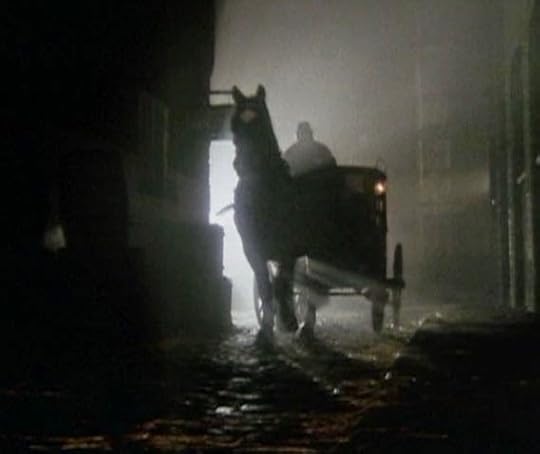
The need for street lighting was recognized as long ago at 1417 when the then Lord Major of London, Sir Henry Barton, ordered that: "Lanterns with lights to be hanged out on the winter evenings between Hallowtide and Candlemass." These lanterns were mainly cheap affairs made out of animal horn scraped until they were thin enough for a light to shine through. The fuel used was whatever came to hand and with choices including animal or vegetable fat, or fish oil; I imagine the lamps smelt stronger than the light they emitted.
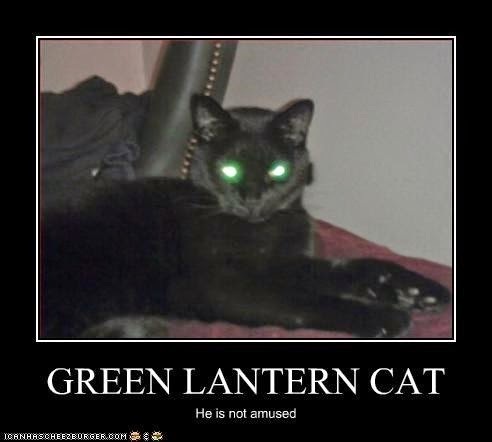
Three hundred years later in 1716 things were formalized with "An Act (of 1716) for Lighting the Streets of the City of London, and Liberties Thereof".This act decreed that all householders with a frontage out onto a public highway or path must show a light between 6-11pm, on threat of a penalty of one shilling (12p). There is not report of how stringently this fine was imposed – I have visions of lamps blowing out in the wind and humble folk being reduced to penury. The fine of a shilling also seems quite steep at a time when a maidservant's average wage for a year was £2 (or 24 shillings).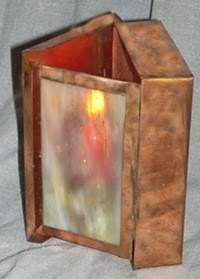 A simple lantern with horn instead of glassAround about the same time as this act, in 1708, a new kind of lamp was patented. "A new kind of light, composed of one entire glass of globular shape, with a lamp, which will give a cleaner and more certain light from all parts thereof."This lamp was first demonstrated outside a coffee house in St James' – presumably to impress wealthy patrons. This brighter light took off quickly with the benefits clear for all to see. In 1725 a visitor to London describes the wonderful illuminations. "Most of the streets are wonderfully lighted, for in front of each house hangs a lantern or a large globe of glass, inside of which is placed a lamp which burns all night. Large houses have two …suspended outside their door by iron supports, and some houses even have four."Cesar de SaussureHowever, this needs to be put into some sense of proportions. Cesar's reference point was almost complete darkness. Testament to the lighting not being that good really, was the James Boswell was able to have "relations" with a prostitute at night in the public setting of Westminster Bridge – and remain undetected.
A simple lantern with horn instead of glassAround about the same time as this act, in 1708, a new kind of lamp was patented. "A new kind of light, composed of one entire glass of globular shape, with a lamp, which will give a cleaner and more certain light from all parts thereof."This lamp was first demonstrated outside a coffee house in St James' – presumably to impress wealthy patrons. This brighter light took off quickly with the benefits clear for all to see. In 1725 a visitor to London describes the wonderful illuminations. "Most of the streets are wonderfully lighted, for in front of each house hangs a lantern or a large globe of glass, inside of which is placed a lamp which burns all night. Large houses have two …suspended outside their door by iron supports, and some houses even have four."Cesar de SaussureHowever, this needs to be put into some sense of proportions. Cesar's reference point was almost complete darkness. Testament to the lighting not being that good really, was the James Boswell was able to have "relations" with a prostitute at night in the public setting of Westminster Bridge – and remain undetected.
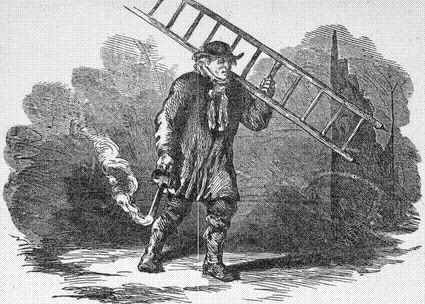 A lamplighter and his ladderHowever, to some the lights remained bright and jolly, and one visitor mistook their reason"…some German prince, who came to London for the first time…seriously believed it [the lights] to have been particularly ordered on account of his arrival."Karl Philip Moritz – diary. 1795 The superior light provided by coal gas had first been recognized by the ancient Chinese. However, it took until the early 19th century for it to be linked to public street lighting. Gas light was first demonstrated on 28thJanuary, 1807, by Frederick Winsor in Pall Mall, London, but it took nearly another 50 years for it to fully catch on.
A lamplighter and his ladderHowever, to some the lights remained bright and jolly, and one visitor mistook their reason"…some German prince, who came to London for the first time…seriously believed it [the lights] to have been particularly ordered on account of his arrival."Karl Philip Moritz – diary. 1795 The superior light provided by coal gas had first been recognized by the ancient Chinese. However, it took until the early 19th century for it to be linked to public street lighting. Gas light was first demonstrated on 28thJanuary, 1807, by Frederick Winsor in Pall Mall, London, but it took nearly another 50 years for it to fully catch on.
Perhaps one of many sceptics was Dr. Johnson. From the window of his house he once watched as the parish lamp lighter climbed his ladder to light the gas lamp. The man was only halfway back down when the flame went out. The lamp-lighter ascended again and this time only had to touch his flame to the residual vapor in the globe. Johnson remarked:"Ah! One of these days the streets of London will be lighted by smoke."
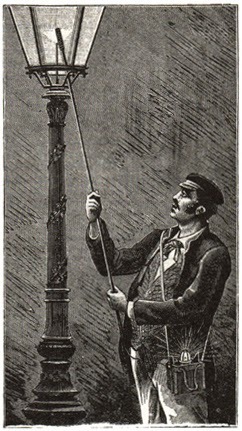
Another sceptic was Sir Humphrey Davy, who ridiculed the trend for gas light, asked archly:"If it were intended to take the dome of St Paul's cathedral for a gasometer?"Each gas lamp had a horizontal bar either side of the globe for the lamplighter to rest his ladder against. Wandering the streets during the night, these men also had a civic duty as patrol or watchmen.
Before I complain more about the street lights being turned off, it is salient to review the power (or lack) of Victorian lamps. The light given off was equivalent to a modern 25 Watt light bulb, and each lamp was placed 65 meters apart. The idea, it seems, was to give the night traveler a distant point of light to head towards, rather than to light the way.

The need for street lighting was recognized as long ago at 1417 when the then Lord Major of London, Sir Henry Barton, ordered that: "Lanterns with lights to be hanged out on the winter evenings between Hallowtide and Candlemass." These lanterns were mainly cheap affairs made out of animal horn scraped until they were thin enough for a light to shine through. The fuel used was whatever came to hand and with choices including animal or vegetable fat, or fish oil; I imagine the lamps smelt stronger than the light they emitted.

Three hundred years later in 1716 things were formalized with "An Act (of 1716) for Lighting the Streets of the City of London, and Liberties Thereof".This act decreed that all householders with a frontage out onto a public highway or path must show a light between 6-11pm, on threat of a penalty of one shilling (12p). There is not report of how stringently this fine was imposed – I have visions of lamps blowing out in the wind and humble folk being reduced to penury. The fine of a shilling also seems quite steep at a time when a maidservant's average wage for a year was £2 (or 24 shillings).
 A simple lantern with horn instead of glassAround about the same time as this act, in 1708, a new kind of lamp was patented. "A new kind of light, composed of one entire glass of globular shape, with a lamp, which will give a cleaner and more certain light from all parts thereof."This lamp was first demonstrated outside a coffee house in St James' – presumably to impress wealthy patrons. This brighter light took off quickly with the benefits clear for all to see. In 1725 a visitor to London describes the wonderful illuminations. "Most of the streets are wonderfully lighted, for in front of each house hangs a lantern or a large globe of glass, inside of which is placed a lamp which burns all night. Large houses have two …suspended outside their door by iron supports, and some houses even have four."Cesar de SaussureHowever, this needs to be put into some sense of proportions. Cesar's reference point was almost complete darkness. Testament to the lighting not being that good really, was the James Boswell was able to have "relations" with a prostitute at night in the public setting of Westminster Bridge – and remain undetected.
A simple lantern with horn instead of glassAround about the same time as this act, in 1708, a new kind of lamp was patented. "A new kind of light, composed of one entire glass of globular shape, with a lamp, which will give a cleaner and more certain light from all parts thereof."This lamp was first demonstrated outside a coffee house in St James' – presumably to impress wealthy patrons. This brighter light took off quickly with the benefits clear for all to see. In 1725 a visitor to London describes the wonderful illuminations. "Most of the streets are wonderfully lighted, for in front of each house hangs a lantern or a large globe of glass, inside of which is placed a lamp which burns all night. Large houses have two …suspended outside their door by iron supports, and some houses even have four."Cesar de SaussureHowever, this needs to be put into some sense of proportions. Cesar's reference point was almost complete darkness. Testament to the lighting not being that good really, was the James Boswell was able to have "relations" with a prostitute at night in the public setting of Westminster Bridge – and remain undetected.
 A lamplighter and his ladderHowever, to some the lights remained bright and jolly, and one visitor mistook their reason"…some German prince, who came to London for the first time…seriously believed it [the lights] to have been particularly ordered on account of his arrival."Karl Philip Moritz – diary. 1795 The superior light provided by coal gas had first been recognized by the ancient Chinese. However, it took until the early 19th century for it to be linked to public street lighting. Gas light was first demonstrated on 28thJanuary, 1807, by Frederick Winsor in Pall Mall, London, but it took nearly another 50 years for it to fully catch on.
A lamplighter and his ladderHowever, to some the lights remained bright and jolly, and one visitor mistook their reason"…some German prince, who came to London for the first time…seriously believed it [the lights] to have been particularly ordered on account of his arrival."Karl Philip Moritz – diary. 1795 The superior light provided by coal gas had first been recognized by the ancient Chinese. However, it took until the early 19th century for it to be linked to public street lighting. Gas light was first demonstrated on 28thJanuary, 1807, by Frederick Winsor in Pall Mall, London, but it took nearly another 50 years for it to fully catch on.Perhaps one of many sceptics was Dr. Johnson. From the window of his house he once watched as the parish lamp lighter climbed his ladder to light the gas lamp. The man was only halfway back down when the flame went out. The lamp-lighter ascended again and this time only had to touch his flame to the residual vapor in the globe. Johnson remarked:"Ah! One of these days the streets of London will be lighted by smoke."

Another sceptic was Sir Humphrey Davy, who ridiculed the trend for gas light, asked archly:"If it were intended to take the dome of St Paul's cathedral for a gasometer?"Each gas lamp had a horizontal bar either side of the globe for the lamplighter to rest his ladder against. Wandering the streets during the night, these men also had a civic duty as patrol or watchmen.
Before I complain more about the street lights being turned off, it is salient to review the power (or lack) of Victorian lamps. The light given off was equivalent to a modern 25 Watt light bulb, and each lamp was placed 65 meters apart. The idea, it seems, was to give the night traveler a distant point of light to head towards, rather than to light the way.

Published on September 24, 2014 05:00
September 16, 2014
Bud the Bulldog's Epic Road Trip across the US
A treat today with an extra post about the epic journey of Bud, the bulldog, as co-driver in the first ever road trip across the US (and some hints on traveling with pets).
In 1903 Bud was "co-driver" of the first ever motor vehicle to travel coast to coast across the US. The car was an open-top Winton, nick-named Vermont, with a top speed of 30 mph. In an era when there were approximately 150 miles of metaled road in the entire country, this epic trip took 63 days. Neither were there gas stations (the first gas station was established in 1905) and fuel had to be obtained along the way from general stores that kept a supply of gas for farm machinery.
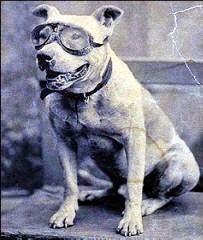 Bud the bulldogThe trip was the idea of the magnificently named, Dr. Horatio Nelson Jackson. However, he did not set off with a dog, but acquired one along the way. The story goes that Jackson left his coat at a hotel, and realizing his mistake turned back to fetch it. On the road, he was stopped by a man asking if he wanted to buy a dog as a mascot. That dog was Bud, a light-colored bulldog, and Jackson, who had been thinking of getting a dog anyway, agreed and the princely sum of $15 changed hands.
Bud the bulldogThe trip was the idea of the magnificently named, Dr. Horatio Nelson Jackson. However, he did not set off with a dog, but acquired one along the way. The story goes that Jackson left his coat at a hotel, and realizing his mistake turned back to fetch it. On the road, he was stopped by a man asking if he wanted to buy a dog as a mascot. That dog was Bud, a light-colored bulldog, and Jackson, who had been thinking of getting a dog anyway, agreed and the princely sum of $15 changed hands.
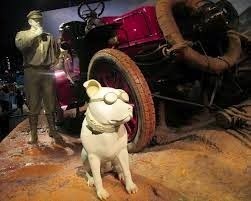 A model of Bud beside Vermont
A model of Bud beside Vermont
Bud soon took to his new life, especially once equipped with a pair of goggles to keep dust out of his eyes. He sat beside his new master on the passenger seat, staring intently at the road ahead and quickly became adept at bracing himself against the lumps and bumps on rocky tracks. Of course, there is no mention of seatbelts, or other safety devices, but there again I don't suppose they encountered many motor vehicles coming in the opposite direction on their journey.
How things have changed! These days it is essential to be safety conscious when traveling with animals. To make the trip stress-free for pets and humans alike, it is best to plan ahead. If you would like some tips on traveling with pets and to read the full article, click on any of Bud's pictures.
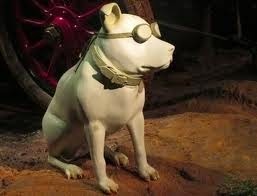 A close up of Bud
A close up of Bud
In 1903 Bud was "co-driver" of the first ever motor vehicle to travel coast to coast across the US. The car was an open-top Winton, nick-named Vermont, with a top speed of 30 mph. In an era when there were approximately 150 miles of metaled road in the entire country, this epic trip took 63 days. Neither were there gas stations (the first gas station was established in 1905) and fuel had to be obtained along the way from general stores that kept a supply of gas for farm machinery.
 Bud the bulldogThe trip was the idea of the magnificently named, Dr. Horatio Nelson Jackson. However, he did not set off with a dog, but acquired one along the way. The story goes that Jackson left his coat at a hotel, and realizing his mistake turned back to fetch it. On the road, he was stopped by a man asking if he wanted to buy a dog as a mascot. That dog was Bud, a light-colored bulldog, and Jackson, who had been thinking of getting a dog anyway, agreed and the princely sum of $15 changed hands.
Bud the bulldogThe trip was the idea of the magnificently named, Dr. Horatio Nelson Jackson. However, he did not set off with a dog, but acquired one along the way. The story goes that Jackson left his coat at a hotel, and realizing his mistake turned back to fetch it. On the road, he was stopped by a man asking if he wanted to buy a dog as a mascot. That dog was Bud, a light-colored bulldog, and Jackson, who had been thinking of getting a dog anyway, agreed and the princely sum of $15 changed hands.
 A model of Bud beside Vermont
A model of Bud beside VermontBud soon took to his new life, especially once equipped with a pair of goggles to keep dust out of his eyes. He sat beside his new master on the passenger seat, staring intently at the road ahead and quickly became adept at bracing himself against the lumps and bumps on rocky tracks. Of course, there is no mention of seatbelts, or other safety devices, but there again I don't suppose they encountered many motor vehicles coming in the opposite direction on their journey.
How things have changed! These days it is essential to be safety conscious when traveling with animals. To make the trip stress-free for pets and humans alike, it is best to plan ahead. If you would like some tips on traveling with pets and to read the full article, click on any of Bud's pictures.
 A close up of Bud
A close up of Bud
Published on September 16, 2014 00:57
September 10, 2014
The History Perspective: Dog Care
Sage advice from a dog book about treating a sick animal:"A change of air and diet will sometimes renovate when all remedies fail: a change from city to country, from greasy meat to fresh milk, from a confined yard to the green fields, will generally revive him without the aid of medicine."

Q: From which decade does this advice originate?a) The 1960sb) The 1860sc) The 1760s
To help you make up your mind let's take a look at some further advice. This time about inadvertent harm done to lapdogs by coddling them too much.
"Nursing in the lap is injurious; not of itself, but the animal is thereby subjected to constant chills, in emerging from a snoozy warmth to a cold carpet or chilly bed. A dog accustomed to the lap is always shivering after it."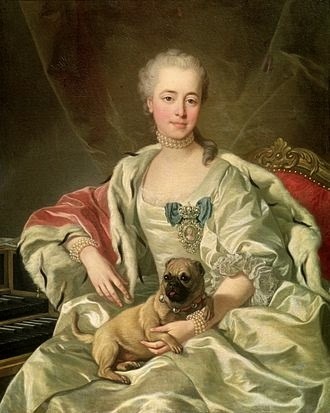 This lapdog may be in danger of chilling Sounds like common sense, if a little extreme. What the author is saying is that pet dogs are done a disservice when treated like toys rather than dogs. A valid argument. Some more common sense along the same lines…
This lapdog may be in danger of chilling Sounds like common sense, if a little extreme. What the author is saying is that pet dogs are done a disservice when treated like toys rather than dogs. A valid argument. Some more common sense along the same lines…
"The tenderly-nursed pet is affected by every change of atmosphere, and subjected to a variety of diseases unknown to the dog that has been hardened since his birth. I ask you, then, neither to stuff nor starve; neither to chill nor burn."
I for one, agree with that. But perhaps the next statement is more controversial, especial amongst owners of dogs that are "faddy" eaters.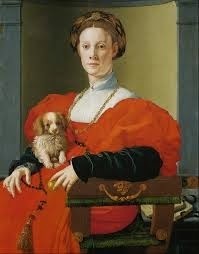 Oh dear, another lapdog in danger"Lack of appetite, so common to pampered favourites, is generally the result of an overloaded stomach and disordered digestion. This is easily cured by medicine, but more safely and simply without it. Fast him for twenty-four hours; after which , keep him on half his ordinary allowance. If this agrees with him, and he keeps in fair condition, continue the regimen."
Oh dear, another lapdog in danger"Lack of appetite, so common to pampered favourites, is generally the result of an overloaded stomach and disordered digestion. This is easily cured by medicine, but more safely and simply without it. Fast him for twenty-four hours; after which , keep him on half his ordinary allowance. If this agrees with him, and he keeps in fair condition, continue the regimen."
That said, the author isn't totally oblivious to the fact that some small dogs are more delicate than others – especially when it comes to bathing.
"Great care should be taken in the washing of delicate dogs. When this operation is performed, they should be rubbed perfectly dry; after which they should be covered, and remain so till the shivering has completely subsided." Cover the dog until shivering subsidesHave you guessed the decade yet? To give you a helping hand, let's look at some of the other events that took place the year this book was published. - Charing Cross railway station, London, opened for the first time- Overarm bowling was ruled as legal in the game of cricket- On the 11th and 12th of March the Great Flood of Sheffield took place, with loss of lifeAnd these final clues are a bit of a give away- The serialization of Charles Dickens' "Our Mutual Friend" began- Lord Palmerston was the British Prime Minister and Queen Victoria was on the throne.
Cover the dog until shivering subsidesHave you guessed the decade yet? To give you a helping hand, let's look at some of the other events that took place the year this book was published. - Charing Cross railway station, London, opened for the first time- Overarm bowling was ruled as legal in the game of cricket- On the 11th and 12th of March the Great Flood of Sheffield took place, with loss of lifeAnd these final clues are a bit of a give away- The serialization of Charles Dickens' "Our Mutual Friend" began- Lord Palmerston was the British Prime Minister and Queen Victoria was on the throne.
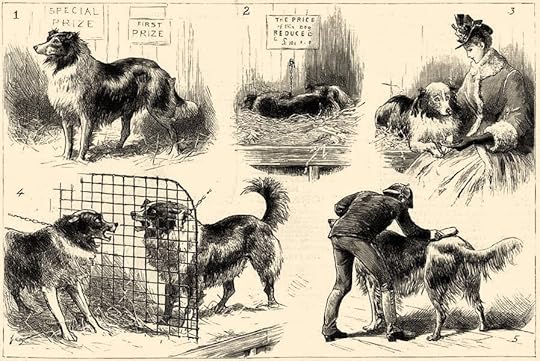 An illustration from Edward Jesse's
An illustration from Edward Jesse's
"Anecdotes of dogs"
Yes! You guessed it, the correct answer is (b) the 1860s – or 1864 to be precise.In 1864 Edward Jesse's popular book "Anecdotes of Dogs" was published – and I'm pleased to say it is still available (as an eBook) a century and a half later – although he views are perhaps a little outdated, the book is still a joy to read.

Q: From which decade does this advice originate?a) The 1960sb) The 1860sc) The 1760s
To help you make up your mind let's take a look at some further advice. This time about inadvertent harm done to lapdogs by coddling them too much.
"Nursing in the lap is injurious; not of itself, but the animal is thereby subjected to constant chills, in emerging from a snoozy warmth to a cold carpet or chilly bed. A dog accustomed to the lap is always shivering after it."
 This lapdog may be in danger of chilling Sounds like common sense, if a little extreme. What the author is saying is that pet dogs are done a disservice when treated like toys rather than dogs. A valid argument. Some more common sense along the same lines…
This lapdog may be in danger of chilling Sounds like common sense, if a little extreme. What the author is saying is that pet dogs are done a disservice when treated like toys rather than dogs. A valid argument. Some more common sense along the same lines…"The tenderly-nursed pet is affected by every change of atmosphere, and subjected to a variety of diseases unknown to the dog that has been hardened since his birth. I ask you, then, neither to stuff nor starve; neither to chill nor burn."
I for one, agree with that. But perhaps the next statement is more controversial, especial amongst owners of dogs that are "faddy" eaters.
 Oh dear, another lapdog in danger"Lack of appetite, so common to pampered favourites, is generally the result of an overloaded stomach and disordered digestion. This is easily cured by medicine, but more safely and simply without it. Fast him for twenty-four hours; after which , keep him on half his ordinary allowance. If this agrees with him, and he keeps in fair condition, continue the regimen."
Oh dear, another lapdog in danger"Lack of appetite, so common to pampered favourites, is generally the result of an overloaded stomach and disordered digestion. This is easily cured by medicine, but more safely and simply without it. Fast him for twenty-four hours; after which , keep him on half his ordinary allowance. If this agrees with him, and he keeps in fair condition, continue the regimen."That said, the author isn't totally oblivious to the fact that some small dogs are more delicate than others – especially when it comes to bathing.
"Great care should be taken in the washing of delicate dogs. When this operation is performed, they should be rubbed perfectly dry; after which they should be covered, and remain so till the shivering has completely subsided."
 Cover the dog until shivering subsidesHave you guessed the decade yet? To give you a helping hand, let's look at some of the other events that took place the year this book was published. - Charing Cross railway station, London, opened for the first time- Overarm bowling was ruled as legal in the game of cricket- On the 11th and 12th of March the Great Flood of Sheffield took place, with loss of lifeAnd these final clues are a bit of a give away- The serialization of Charles Dickens' "Our Mutual Friend" began- Lord Palmerston was the British Prime Minister and Queen Victoria was on the throne.
Cover the dog until shivering subsidesHave you guessed the decade yet? To give you a helping hand, let's look at some of the other events that took place the year this book was published. - Charing Cross railway station, London, opened for the first time- Overarm bowling was ruled as legal in the game of cricket- On the 11th and 12th of March the Great Flood of Sheffield took place, with loss of lifeAnd these final clues are a bit of a give away- The serialization of Charles Dickens' "Our Mutual Friend" began- Lord Palmerston was the British Prime Minister and Queen Victoria was on the throne.
 An illustration from Edward Jesse's
An illustration from Edward Jesse's"Anecdotes of dogs"
Yes! You guessed it, the correct answer is (b) the 1860s – or 1864 to be precise.In 1864 Edward Jesse's popular book "Anecdotes of Dogs" was published – and I'm pleased to say it is still available (as an eBook) a century and a half later – although he views are perhaps a little outdated, the book is still a joy to read.

Published on September 10, 2014 14:15
September 3, 2014
A Tale of Two Cities and a Dyslexic Artist
This week's blog is up a little late, courtesy of my son – read on to find out why. For the same reason the post differs from the usual historical fare and is about Las Vegas (and Los Angeles)
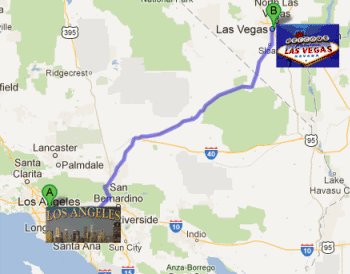 Los Angeles and Las Vegas - hey ho! But first, to understand the background to this post. My son is studying fine art and won a travel prize, with a proposal to visit Nevada to draw and paint the rocks (small scale rocks, rather than large scale landscape…but that’s another story). The plan was for him and a friend to fly to Las Vegas and drive out into the desert in an RV.
Los Angeles and Las Vegas - hey ho! But first, to understand the background to this post. My son is studying fine art and won a travel prize, with a proposal to visit Nevada to draw and paint the rocks (small scale rocks, rather than large scale landscape…but that’s another story). The plan was for him and a friend to fly to Las Vegas and drive out into the desert in an RV.
He's been excited about visiting Las Vegas for weeks, and yesterday, with one more sleep to go he was double-checking arrangements. But…oh no…disaster! Las VegasIt turns out he'd booked to pick up and drop off the RV from Los Angeles – NOT Las Vegas! The problem is that he's dyslexic and spotting the "L" he felt confident he'd got the right place and went ahead and booked. Aged 21, and no longer living at home, we trusted him to make the arrangements. Oh dear.
Las VegasIt turns out he'd booked to pick up and drop off the RV from Los Angeles – NOT Las Vegas! The problem is that he's dyslexic and spotting the "L" he felt confident he'd got the right place and went ahead and booked. Aged 21, and no longer living at home, we trusted him to make the arrangements. Oh dear.
Long story short we had a hell of a 24 hours but fingers crossed, with parental intervention things are back to Plan A. I took him and his friend to Heathrow this morning – so it's now out of my hands. Anyhow, I decided to use this as an excuse to find some Las Vegas trivia. I'd love to hear any experiences you have of Vegas, so do chip in and comment. Los Angeles
Los Angeles
Las Vegas Trivia
Las Vegas means "The Meadows" in Spanish (ironically named I presume, given the desert setting.)
Vegas Vic – the huge neon cowboy standing over Fremont Street, is the world's largest mechanical neon sign. But in a town with 15,000 miles of neon tubing, what do you expect?
Vegas has 30 million (plus 2) visitors a year, and the native population is around 1.7 million.
The extravagant fountains and water features are supplied with "grey water". This is water reclaimed from bath tubs, showers, and washing machines. The water if filtered, cleaned and chlorinated before use. Thank goodness they don't use "black water", which is that which goes through the toilets and the sewers.
The average length of stay in Vegas is 3.7 days (or around 90 minutes if you are my son, who has to catch a bus from the airport to Los Angeles).
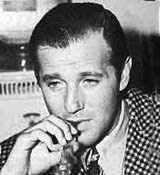 Ben "Bugsy" SiegalWhat Do Las Vegas and Los Angeles have in Common?
Ben "Bugsy" SiegalWhat Do Las Vegas and Los Angeles have in Common?
They both begin with the letter "L".
Also, gangster Ben "Bugsy" Siegal founded the Flamingo hotel, Vegas in 1946 using mob moneny. He named the Flamingo Hotel (where my son stays on his final night) after the long legs of his showgirl girlfriend. However, Bugsy died in Los Angeles, shot dead whilst reading a newspaper in Los Angeles – probably because he skimmed mob money.
So there we have it. A tale of two cities and a dyslexic artist. Ho hum.
 Los Angeles and Las Vegas - hey ho! But first, to understand the background to this post. My son is studying fine art and won a travel prize, with a proposal to visit Nevada to draw and paint the rocks (small scale rocks, rather than large scale landscape…but that’s another story). The plan was for him and a friend to fly to Las Vegas and drive out into the desert in an RV.
Los Angeles and Las Vegas - hey ho! But first, to understand the background to this post. My son is studying fine art and won a travel prize, with a proposal to visit Nevada to draw and paint the rocks (small scale rocks, rather than large scale landscape…but that’s another story). The plan was for him and a friend to fly to Las Vegas and drive out into the desert in an RV. He's been excited about visiting Las Vegas for weeks, and yesterday, with one more sleep to go he was double-checking arrangements. But…oh no…disaster!
 Las VegasIt turns out he'd booked to pick up and drop off the RV from Los Angeles – NOT Las Vegas! The problem is that he's dyslexic and spotting the "L" he felt confident he'd got the right place and went ahead and booked. Aged 21, and no longer living at home, we trusted him to make the arrangements. Oh dear.
Las VegasIt turns out he'd booked to pick up and drop off the RV from Los Angeles – NOT Las Vegas! The problem is that he's dyslexic and spotting the "L" he felt confident he'd got the right place and went ahead and booked. Aged 21, and no longer living at home, we trusted him to make the arrangements. Oh dear. Long story short we had a hell of a 24 hours but fingers crossed, with parental intervention things are back to Plan A. I took him and his friend to Heathrow this morning – so it's now out of my hands. Anyhow, I decided to use this as an excuse to find some Las Vegas trivia. I'd love to hear any experiences you have of Vegas, so do chip in and comment.
 Los Angeles
Los AngelesLas Vegas Trivia
Las Vegas means "The Meadows" in Spanish (ironically named I presume, given the desert setting.)
Vegas Vic – the huge neon cowboy standing over Fremont Street, is the world's largest mechanical neon sign. But in a town with 15,000 miles of neon tubing, what do you expect?
Vegas has 30 million (plus 2) visitors a year, and the native population is around 1.7 million.
The extravagant fountains and water features are supplied with "grey water". This is water reclaimed from bath tubs, showers, and washing machines. The water if filtered, cleaned and chlorinated before use. Thank goodness they don't use "black water", which is that which goes through the toilets and the sewers.
The average length of stay in Vegas is 3.7 days (or around 90 minutes if you are my son, who has to catch a bus from the airport to Los Angeles).
 Ben "Bugsy" SiegalWhat Do Las Vegas and Los Angeles have in Common?
Ben "Bugsy" SiegalWhat Do Las Vegas and Los Angeles have in Common?They both begin with the letter "L".
Also, gangster Ben "Bugsy" Siegal founded the Flamingo hotel, Vegas in 1946 using mob moneny. He named the Flamingo Hotel (where my son stays on his final night) after the long legs of his showgirl girlfriend. However, Bugsy died in Los Angeles, shot dead whilst reading a newspaper in Los Angeles – probably because he skimmed mob money.
So there we have it. A tale of two cities and a dyslexic artist. Ho hum.

Published on September 03, 2014 11:11
August 27, 2014
Of Noble Dogs and Nobility
"Histories are more full of examples of fidelity of dogs than of friends." Alexander Pope
Alexander Pope wrote this at the beginning of the 18thcentury, in agreement with the sentiments of King Frederick II of Denmark. Indeed, some histories have it that the latter 16th century king created the country's highest order of merit in order to honour his dog, Wilpret.
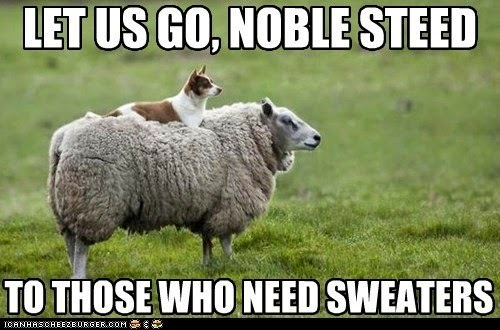
King Frederick II had a reputation for being a man who enjoyed life to the full. He had a penchant for wine, woman, hunting, and feasts, and some even say that he drank himself to death. But perhaps being hot-headed, vain, and ambitious hides an underlying disappointment in the fidelity of the human race. It seems the one constant in his world was his dog, Wilpret. 1581, King Frederick II of DenmarkIt is said that Frederick honoured Wilpret by awarding the dog the Chief Order of Denmark (which later became the Order of the Elephant – an honour only bestowed on royalty, or people of exceptional importance.) This is backed up by an gilded plaque, now hanging in the Wallace Collection, London, showing a mounted Frederick. The plaque bears the inscription:"My trust is in God alone, Wilpret is true."In a world of shifting allegiance, Frederick's dog at least was constant.
1581, King Frederick II of DenmarkIt is said that Frederick honoured Wilpret by awarding the dog the Chief Order of Denmark (which later became the Order of the Elephant – an honour only bestowed on royalty, or people of exceptional importance.) This is backed up by an gilded plaque, now hanging in the Wallace Collection, London, showing a mounted Frederick. The plaque bears the inscription:"My trust is in God alone, Wilpret is true."In a world of shifting allegiance, Frederick's dog at least was constant.
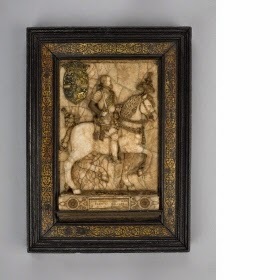 Frederick's plaque - on display at the Wallace collection, London.Writing a little of over a century later, Alexander Pope applauds this recognition of canine allegiance."A modern instance of gratitude to a dog is that the Chief Order of Denmark (now call'd the Order of the Elephant) was instituted in memory of the fidelity of a dog nam'd Wild-Brat [sic]."
Frederick's plaque - on display at the Wallace collection, London.Writing a little of over a century later, Alexander Pope applauds this recognition of canine allegiance."A modern instance of gratitude to a dog is that the Chief Order of Denmark (now call'd the Order of the Elephant) was instituted in memory of the fidelity of a dog nam'd Wild-Brat [sic]."
However, some people believed that dogs had a place, and that wasn't necessarily at a king's side in the council chamber. Samuel Pepys, writing in his diary in 1667, seems irritated by King Charles II playing with his dogs during a meeting. "the silliness of the King, playing with is dog all the while, or his codpiece, and minding the business." The spaniels that Charles so favoured. With the Stuart family history it is easy to understand why Charles had a low opinion of people and only truly trusted his dogs. As Bishop Burnet remarked after Charles' death:"He thought that no one did serve him out of love…"Although, the constant companionship of faithful canine companions hopefully brought some comfort. Indeed, they did go everywhere with him, as this poem by Lord Rochester implies:"His very dog at Council Board,Sits grave and wise as any Lord."Perhaps one of the reasons why Charles loved dogs was that they put on no airs and graces in his company. Indeed, whilst traveling on a barge with "a dog the King loved", Samuel Pepys writes how the dog fouled in the boat.“which made us laugh, and me think that a King and all that belongs to him are but just as others are.”
The spaniels that Charles so favoured. With the Stuart family history it is easy to understand why Charles had a low opinion of people and only truly trusted his dogs. As Bishop Burnet remarked after Charles' death:"He thought that no one did serve him out of love…"Although, the constant companionship of faithful canine companions hopefully brought some comfort. Indeed, they did go everywhere with him, as this poem by Lord Rochester implies:"His very dog at Council Board,Sits grave and wise as any Lord."Perhaps one of the reasons why Charles loved dogs was that they put on no airs and graces in his company. Indeed, whilst traveling on a barge with "a dog the King loved", Samuel Pepys writes how the dog fouled in the boat.“which made us laugh, and me think that a King and all that belongs to him are but just as others are.”
Perhaps that's the point, and dogs don't see class or station, but offer unconditional devotion and love. No relevance to this post I'm afraid!
No relevance to this post I'm afraid!
Just too cute.
Alexander Pope wrote this at the beginning of the 18thcentury, in agreement with the sentiments of King Frederick II of Denmark. Indeed, some histories have it that the latter 16th century king created the country's highest order of merit in order to honour his dog, Wilpret.

King Frederick II had a reputation for being a man who enjoyed life to the full. He had a penchant for wine, woman, hunting, and feasts, and some even say that he drank himself to death. But perhaps being hot-headed, vain, and ambitious hides an underlying disappointment in the fidelity of the human race. It seems the one constant in his world was his dog, Wilpret.
 1581, King Frederick II of DenmarkIt is said that Frederick honoured Wilpret by awarding the dog the Chief Order of Denmark (which later became the Order of the Elephant – an honour only bestowed on royalty, or people of exceptional importance.) This is backed up by an gilded plaque, now hanging in the Wallace Collection, London, showing a mounted Frederick. The plaque bears the inscription:"My trust is in God alone, Wilpret is true."In a world of shifting allegiance, Frederick's dog at least was constant.
1581, King Frederick II of DenmarkIt is said that Frederick honoured Wilpret by awarding the dog the Chief Order of Denmark (which later became the Order of the Elephant – an honour only bestowed on royalty, or people of exceptional importance.) This is backed up by an gilded plaque, now hanging in the Wallace Collection, London, showing a mounted Frederick. The plaque bears the inscription:"My trust is in God alone, Wilpret is true."In a world of shifting allegiance, Frederick's dog at least was constant.
 Frederick's plaque - on display at the Wallace collection, London.Writing a little of over a century later, Alexander Pope applauds this recognition of canine allegiance."A modern instance of gratitude to a dog is that the Chief Order of Denmark (now call'd the Order of the Elephant) was instituted in memory of the fidelity of a dog nam'd Wild-Brat [sic]."
Frederick's plaque - on display at the Wallace collection, London.Writing a little of over a century later, Alexander Pope applauds this recognition of canine allegiance."A modern instance of gratitude to a dog is that the Chief Order of Denmark (now call'd the Order of the Elephant) was instituted in memory of the fidelity of a dog nam'd Wild-Brat [sic]."However, some people believed that dogs had a place, and that wasn't necessarily at a king's side in the council chamber. Samuel Pepys, writing in his diary in 1667, seems irritated by King Charles II playing with his dogs during a meeting. "the silliness of the King, playing with is dog all the while, or his codpiece, and minding the business."
 The spaniels that Charles so favoured. With the Stuart family history it is easy to understand why Charles had a low opinion of people and only truly trusted his dogs. As Bishop Burnet remarked after Charles' death:"He thought that no one did serve him out of love…"Although, the constant companionship of faithful canine companions hopefully brought some comfort. Indeed, they did go everywhere with him, as this poem by Lord Rochester implies:"His very dog at Council Board,Sits grave and wise as any Lord."Perhaps one of the reasons why Charles loved dogs was that they put on no airs and graces in his company. Indeed, whilst traveling on a barge with "a dog the King loved", Samuel Pepys writes how the dog fouled in the boat.“which made us laugh, and me think that a King and all that belongs to him are but just as others are.”
The spaniels that Charles so favoured. With the Stuart family history it is easy to understand why Charles had a low opinion of people and only truly trusted his dogs. As Bishop Burnet remarked after Charles' death:"He thought that no one did serve him out of love…"Although, the constant companionship of faithful canine companions hopefully brought some comfort. Indeed, they did go everywhere with him, as this poem by Lord Rochester implies:"His very dog at Council Board,Sits grave and wise as any Lord."Perhaps one of the reasons why Charles loved dogs was that they put on no airs and graces in his company. Indeed, whilst traveling on a barge with "a dog the King loved", Samuel Pepys writes how the dog fouled in the boat.“which made us laugh, and me think that a King and all that belongs to him are but just as others are.” Perhaps that's the point, and dogs don't see class or station, but offer unconditional devotion and love.
 No relevance to this post I'm afraid!
No relevance to this post I'm afraid!Just too cute.
Published on August 27, 2014 01:36
August 20, 2014
A Cur : A Compliment Not a Curse
"A dog of mixed type, especially one that is frightening or fierce." Oxford Dictionary
Times and language change. Last night, whilst reading "Anecdotes of Dogs" – a charming book written by Edward Jesse in 1858, this was brought home to me in the table of contents. Reading through chapters listing dog breeds, nestled between "the Great Danish dog" and "the Lurcher", was "the Cur".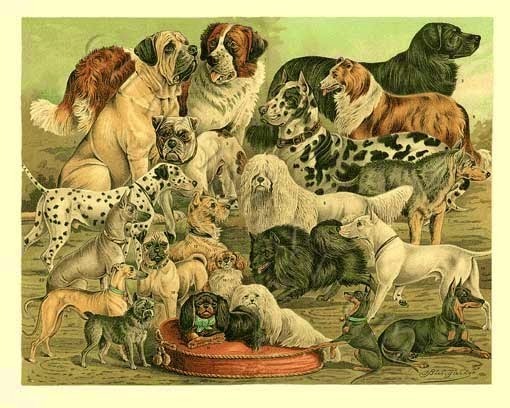
I am more familiar with "cur" being used in historical fiction as an unflattering curse, as in "You cur, unhand that woman!" but it seems in Victorian times (and presumably pre-dating this) a cur was a type of purpose bred cattle droving dog. Admittedly a cur was of mixed ancestry, but he was a noble working dog all the same.
I decided to skip straight to the chapter on curs, and indeed found out that this forgotten strain of dogs were shot through with fine instincts and loyalty to their owners- far removed from the modern implication.

The first (true) story related by Mr. Jesse concerns a merchant's shop in London. A large box properly labelled and seemingly in order, was delivered one evening to stay their overnight and be shipped off with other goods in the morning. A customer and his cur entered the shop whereupon the dog set to sniffing the box and then barking at it with intent to draw attention. This led the merchant to investigate the box, at which point he found a boy hidden inside tasked with the job of letting in his fellow felons after dark, in order to plunder the shop.
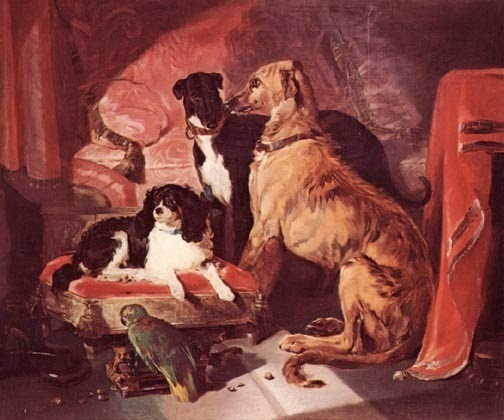
Another moving story is that of a pregnant cur. This bitch belonged to John Lang, Esq, who used her to work his cattle. One day, large with pup, she went into labor whilst working the cattle. She gave birth on the moor, concealed the puppies in a gorse bush and went back to work herding the cattle back home with all diligence. Only once had she handed over her charge did she return to the puppies and brought them home by the scruff, one by one. In Mr. Jesse's account he notes how Mr. Lang preserved the entire litter so as not to distress so faithful an animal (this seems to imply that he might otherwise have destroyed some of them!)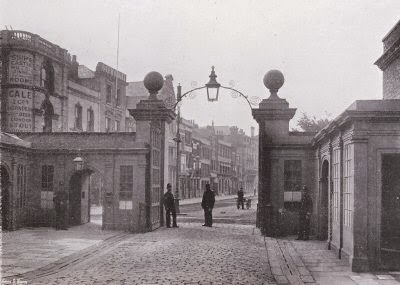 The gates to Portsmouth dockyard - circa 1901Our final tale involves the aptly named "Trusty". This cur belongs to a workman employed in Portsmouth dockyard. The man's wife prepared his meal every day, tied it in a cloth and placed it in a hand-basket. The dog was trained to carry the basket by the handle and cover a distance of a mile or so to deliver it to his master. If the dog tired, he carefully placed the basket on the ground whilst he rested, but growled at anyone who approached. Once he got to the dockyard, he had to wait until a porter noticed him and opened the gate.
The gates to Portsmouth dockyard - circa 1901Our final tale involves the aptly named "Trusty". This cur belongs to a workman employed in Portsmouth dockyard. The man's wife prepared his meal every day, tied it in a cloth and placed it in a hand-basket. The dog was trained to carry the basket by the handle and cover a distance of a mile or so to deliver it to his master. If the dog tired, he carefully placed the basket on the ground whilst he rested, but growled at anyone who approached. Once he got to the dockyard, he had to wait until a porter noticed him and opened the gate.
 Knocking off time at Harland and Wolff shipyard, Belfast
Knocking off time at Harland and Wolff shipyard, Belfast
On finding his master, by all accounts man and dog were equally enamored of one another, and the man shared his food with Trusty. Once finished, the laborer repacked the basket and the dog delivered it safe home again.
There now! Put's a different complexion of the word "cur" doesn't it? Based on these examples it should be a compliment, not a curse.
Times and language change. Last night, whilst reading "Anecdotes of Dogs" – a charming book written by Edward Jesse in 1858, this was brought home to me in the table of contents. Reading through chapters listing dog breeds, nestled between "the Great Danish dog" and "the Lurcher", was "the Cur".

I am more familiar with "cur" being used in historical fiction as an unflattering curse, as in "You cur, unhand that woman!" but it seems in Victorian times (and presumably pre-dating this) a cur was a type of purpose bred cattle droving dog. Admittedly a cur was of mixed ancestry, but he was a noble working dog all the same.
I decided to skip straight to the chapter on curs, and indeed found out that this forgotten strain of dogs were shot through with fine instincts and loyalty to their owners- far removed from the modern implication.

The first (true) story related by Mr. Jesse concerns a merchant's shop in London. A large box properly labelled and seemingly in order, was delivered one evening to stay their overnight and be shipped off with other goods in the morning. A customer and his cur entered the shop whereupon the dog set to sniffing the box and then barking at it with intent to draw attention. This led the merchant to investigate the box, at which point he found a boy hidden inside tasked with the job of letting in his fellow felons after dark, in order to plunder the shop.

Another moving story is that of a pregnant cur. This bitch belonged to John Lang, Esq, who used her to work his cattle. One day, large with pup, she went into labor whilst working the cattle. She gave birth on the moor, concealed the puppies in a gorse bush and went back to work herding the cattle back home with all diligence. Only once had she handed over her charge did she return to the puppies and brought them home by the scruff, one by one. In Mr. Jesse's account he notes how Mr. Lang preserved the entire litter so as not to distress so faithful an animal (this seems to imply that he might otherwise have destroyed some of them!)
 The gates to Portsmouth dockyard - circa 1901Our final tale involves the aptly named "Trusty". This cur belongs to a workman employed in Portsmouth dockyard. The man's wife prepared his meal every day, tied it in a cloth and placed it in a hand-basket. The dog was trained to carry the basket by the handle and cover a distance of a mile or so to deliver it to his master. If the dog tired, he carefully placed the basket on the ground whilst he rested, but growled at anyone who approached. Once he got to the dockyard, he had to wait until a porter noticed him and opened the gate.
The gates to Portsmouth dockyard - circa 1901Our final tale involves the aptly named "Trusty". This cur belongs to a workman employed in Portsmouth dockyard. The man's wife prepared his meal every day, tied it in a cloth and placed it in a hand-basket. The dog was trained to carry the basket by the handle and cover a distance of a mile or so to deliver it to his master. If the dog tired, he carefully placed the basket on the ground whilst he rested, but growled at anyone who approached. Once he got to the dockyard, he had to wait until a porter noticed him and opened the gate.
 Knocking off time at Harland and Wolff shipyard, Belfast
Knocking off time at Harland and Wolff shipyard, BelfastOn finding his master, by all accounts man and dog were equally enamored of one another, and the man shared his food with Trusty. Once finished, the laborer repacked the basket and the dog delivered it safe home again.
There now! Put's a different complexion of the word "cur" doesn't it? Based on these examples it should be a compliment, not a curse.

Published on August 20, 2014 05:20
August 13, 2014
The Painter and His Pug - by guest, Madame Gilflurt
Once again I am indebted to the lovely Madame Gilflurt, (aka Catherine Curzon) with another enchanting post about a pet from history. I have a pet crush on pugs so I'm especially intrigued to read about Trump.
G x
The Painter and His Pug - by Madame Gilflurt
It is no secret that I adore the pets who share my house, nor is it privileged information that my constant companion is Pippa, my wonderful hound. A man who shared my love of dogs is, of course, William Hogarth, the legendary painter who, like my sister, shared his home with a pug.
Hogarth's pug went by the name of Trump and it's fair to say that he was a celebrity in his own right, with small porcelain figures of Trump being sold to Hogarth's fans, whilst the painter himself was on occasion depicted as a pug too!
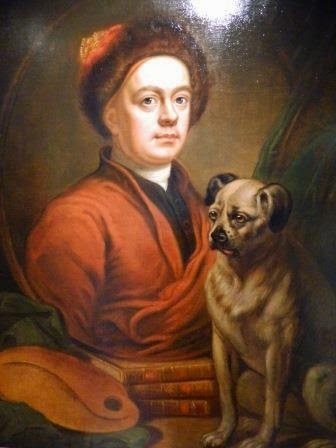 The Painter and his Pug by William Hogarth, 1745
The Painter and his Pug by William Hogarth, 1745
In the 1730s, Hogarth began work on what would become The Painter and his Pug. The work depicts Hogarth as a picture within a frame whilst Trump sits outside it, reality alongside the constructed and framed image of Hogarth. Although the finished portrait shows Hogarth in informal dress, initial work on the canvas showed a very different figure, with the artist resplendent in wig and formal dress. Clearly Hogarth had a rethink though and chose to depict himself as a craftsman, rather than a figure of wealth and importance.
He has taken great care over other aspects of the painting too, as the self-portrait rests atop a bile of books by Milton, Swift and Shakespeare, whilst the palette in the foreground bears the words, Line of Beauty and Grace. Although Hogarth painted out "and Grace", over time it has become visible again and this refers to Hogarth's artistic beliefs set out in his work, The Analysis of Beauty.
The Painter and his Pug was completed in 1745, a decade or so after work on it began. As a dog-lover, it is a painting that immediately speaks to me because of the way in which Trump is presented, obediently sitting before his master alongside the books, palette and words that mean so much to the artist. He is a vital part of Hogarth's life and art, as much a part of his inspiration as the literature on which Hogarth's portrait rests. trump would not be the only pug owned by William Hogarth but his place in history is assured, captured forever in this striking work.
CC.
Glorious Georgian ginbag, gossip and gadabout Catherine Curzon, aka Madame Gilflurt, is the author of A Covent Garden Gilflurt’s Guide to Life. When not setting quill to paper, she can usually be found gadding about the tea shops and gaming rooms of the capital or hosting intimate gatherings at her tottering abode. In addition to her blog and Facebook, Madame G is also quite the charmer on Twitter.
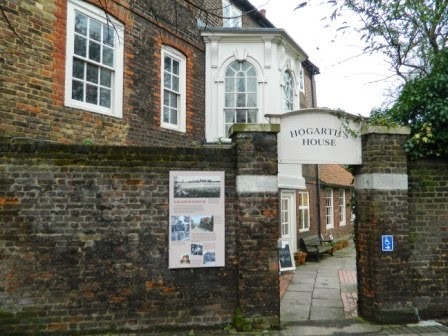
Thank you again, Madame for your wonderful gossip. If ever you are in London, Master Hogarth's House is utterly fascinating, although it now no longer residues in rural idyll but on the edge of one of London's most filthy and ugly arterial roads.
Kindest regards,
Grace x
G x
The Painter and His Pug - by Madame Gilflurt
It is no secret that I adore the pets who share my house, nor is it privileged information that my constant companion is Pippa, my wonderful hound. A man who shared my love of dogs is, of course, William Hogarth, the legendary painter who, like my sister, shared his home with a pug.
Hogarth's pug went by the name of Trump and it's fair to say that he was a celebrity in his own right, with small porcelain figures of Trump being sold to Hogarth's fans, whilst the painter himself was on occasion depicted as a pug too!
 The Painter and his Pug by William Hogarth, 1745
The Painter and his Pug by William Hogarth, 1745 In the 1730s, Hogarth began work on what would become The Painter and his Pug. The work depicts Hogarth as a picture within a frame whilst Trump sits outside it, reality alongside the constructed and framed image of Hogarth. Although the finished portrait shows Hogarth in informal dress, initial work on the canvas showed a very different figure, with the artist resplendent in wig and formal dress. Clearly Hogarth had a rethink though and chose to depict himself as a craftsman, rather than a figure of wealth and importance.
He has taken great care over other aspects of the painting too, as the self-portrait rests atop a bile of books by Milton, Swift and Shakespeare, whilst the palette in the foreground bears the words, Line of Beauty and Grace. Although Hogarth painted out "and Grace", over time it has become visible again and this refers to Hogarth's artistic beliefs set out in his work, The Analysis of Beauty.
The Painter and his Pug was completed in 1745, a decade or so after work on it began. As a dog-lover, it is a painting that immediately speaks to me because of the way in which Trump is presented, obediently sitting before his master alongside the books, palette and words that mean so much to the artist. He is a vital part of Hogarth's life and art, as much a part of his inspiration as the literature on which Hogarth's portrait rests. trump would not be the only pug owned by William Hogarth but his place in history is assured, captured forever in this striking work.
CC.
Glorious Georgian ginbag, gossip and gadabout Catherine Curzon, aka Madame Gilflurt, is the author of A Covent Garden Gilflurt’s Guide to Life. When not setting quill to paper, she can usually be found gadding about the tea shops and gaming rooms of the capital or hosting intimate gatherings at her tottering abode. In addition to her blog and Facebook, Madame G is also quite the charmer on Twitter.

Thank you again, Madame for your wonderful gossip. If ever you are in London, Master Hogarth's House is utterly fascinating, although it now no longer residues in rural idyll but on the edge of one of London's most filthy and ugly arterial roads.
Kindest regards,
Grace x
Published on August 13, 2014 13:18
August 6, 2014
Thomas Gainsborough: The Painter's Daughters with a Cat
Welcome! In the third post of a short series by guest authors, I'm especially pleased to welcome historical blogger extraoridinaire - Madame Gilflurt, aka Catherine Curzon. Madame is a prolific blogger (quite how she keeps it up I've no idea) on things historcial and the pleasure mine that she's popped by today. So without further ado, over to Madame...
Thomas Gainsborough: The Painter's Daughters with a Cat
With the recent anniversary of the death of Thomas Gainsborough, I have spent some time contemplating his work and this particular painting that caught my eye. Gainsborough was known, of course, for his remarkable portraits and landscapes; he enjoyed a most illustrious client list, including some of the most famous names in Georgian society and his reputation has endured throughout the centuries to this very day, deservedly regarded as one of the icons of 18th century art.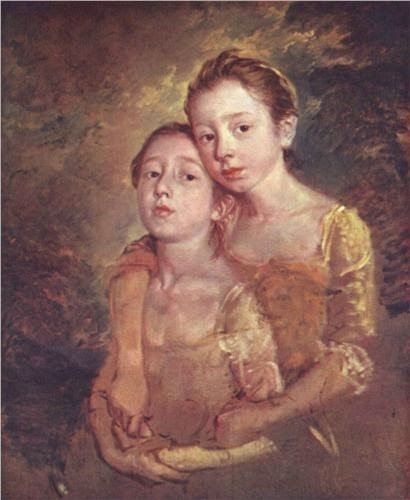
Gainsborough was father to two daughters, Mary and Margaret, born in 1750 and 1751 respectively. He painted them on several occasions and the work that has commanded my attention today is The Painter's Daughters with a Cat, though if you can spot the cat, well done!
This portrait is undated but is believed to have been painted around 1760-61, based on the approximate age of the two girls.The unfinished work shows Mary and Margaret in a casual embrace, looking not directly at the viewer but slightly off to the side, perhaps to where Gainsborough works at the canvas. I find it a striking image and one that captures the spirit of the children, utterly at ease with one another and with with the business of posing for the celebrated artist who to them, was simply a father.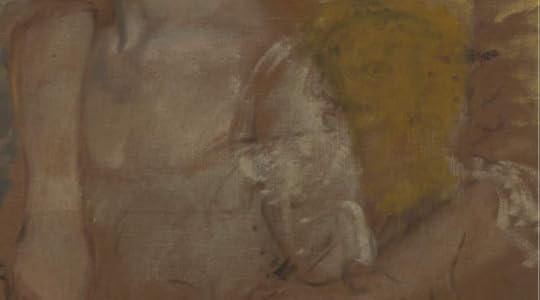 Spot the cat (clue, look at the orange splodge to the right)At a cursory glance the cat may prove hard to locate but look to the lower right of the painting, where a shape can be identified lounging on Margaret's forearm. Reaching over, Margaret is pulling the animal's tail gently and in the outline of its face, we can see that the feline was far from happy!
Spot the cat (clue, look at the orange splodge to the right)At a cursory glance the cat may prove hard to locate but look to the lower right of the painting, where a shape can be identified lounging on Margaret's forearm. Reaching over, Margaret is pulling the animal's tail gently and in the outline of its face, we can see that the feline was far from happy!
Sadly the painting was never finished and as such, we can only catch the barest glimpse of the phantom cat in the little girl's arms, or share this moment of childhood domesticity.
Glorious Georgian ginbag, gossip and gadabout Catherine Curzon, aka Madame Gilflurt, is the author of A Covent Garden Gilflurt’s Guide to Life. When not setting quill to paper, she can usually be found gadding about the tea shops and gaming rooms of the capital or hosting intimate gatherings at her tottering abode. In addition to her blog and Facebook, Madame G is also quite the charmer on Twitter.
Thank you Catherine, for yet another fascinating post. You are welcome any time, especially if you post about animals. G xSorry - couldn't resist - any excuse to repost my son's sketch of Widget (she looks a lot happier than Gainsborough's cat!).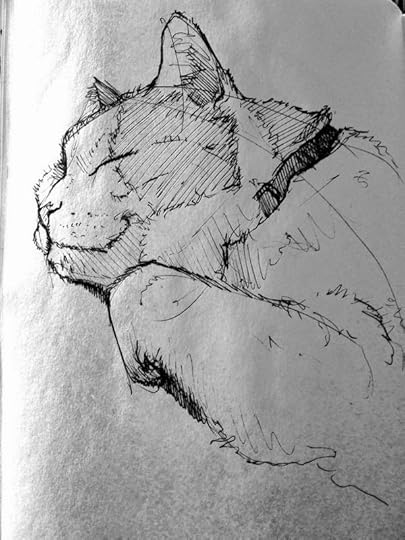
Thomas Gainsborough: The Painter's Daughters with a Cat
With the recent anniversary of the death of Thomas Gainsborough, I have spent some time contemplating his work and this particular painting that caught my eye. Gainsborough was known, of course, for his remarkable portraits and landscapes; he enjoyed a most illustrious client list, including some of the most famous names in Georgian society and his reputation has endured throughout the centuries to this very day, deservedly regarded as one of the icons of 18th century art.

Gainsborough was father to two daughters, Mary and Margaret, born in 1750 and 1751 respectively. He painted them on several occasions and the work that has commanded my attention today is The Painter's Daughters with a Cat, though if you can spot the cat, well done!
This portrait is undated but is believed to have been painted around 1760-61, based on the approximate age of the two girls.The unfinished work shows Mary and Margaret in a casual embrace, looking not directly at the viewer but slightly off to the side, perhaps to where Gainsborough works at the canvas. I find it a striking image and one that captures the spirit of the children, utterly at ease with one another and with with the business of posing for the celebrated artist who to them, was simply a father.
 Spot the cat (clue, look at the orange splodge to the right)At a cursory glance the cat may prove hard to locate but look to the lower right of the painting, where a shape can be identified lounging on Margaret's forearm. Reaching over, Margaret is pulling the animal's tail gently and in the outline of its face, we can see that the feline was far from happy!
Spot the cat (clue, look at the orange splodge to the right)At a cursory glance the cat may prove hard to locate but look to the lower right of the painting, where a shape can be identified lounging on Margaret's forearm. Reaching over, Margaret is pulling the animal's tail gently and in the outline of its face, we can see that the feline was far from happy!Sadly the painting was never finished and as such, we can only catch the barest glimpse of the phantom cat in the little girl's arms, or share this moment of childhood domesticity.
Glorious Georgian ginbag, gossip and gadabout Catherine Curzon, aka Madame Gilflurt, is the author of A Covent Garden Gilflurt’s Guide to Life. When not setting quill to paper, she can usually be found gadding about the tea shops and gaming rooms of the capital or hosting intimate gatherings at her tottering abode. In addition to her blog and Facebook, Madame G is also quite the charmer on Twitter.
Thank you Catherine, for yet another fascinating post. You are welcome any time, especially if you post about animals. G xSorry - couldn't resist - any excuse to repost my son's sketch of Widget (she looks a lot happier than Gainsborough's cat!).

Published on August 06, 2014 10:55
July 30, 2014
Pangur Ban, a Medieval Cat Poem - by Guest, Kim Rendfeld
I'm delighted to welcome author of historical fiction, Kim Rendfeld, to Fall in Love with History. Kim posts on a subject very close to my heart - cats. I love learning about how cats were depicted in early centuries, and the delightful poem about an Irish monk's cat is a new treasure. So without further ado, over to Kim.
G x
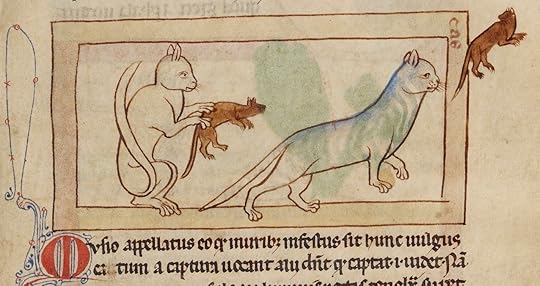 The delightfully titled "Katzen und Maeuses"When you read about early medieval times, you expect war and brutal justice, not a charming poem about a cat. But such a thing does exists, and it was a pleasant surprise in my research for my novels. I stumbled across “Pangur Ban” in Pierre Riche’s Daily Life in the World of Charlemagne. Written in the margins of a manuscript found in a monastery in today’s Austria, this ninth-century piece is about a cat named Pangur Ban, written by an Irish monk. In the poem, the author compares his hunt for knowledge to the cat’s hunt for mice and describes the satisfaction both get from their arts. (A kind soul has posted two translations of the poem at http://homepages.wmich.edu/~cooneys/poems/pangur.ban.html .)
The delightfully titled "Katzen und Maeuses"When you read about early medieval times, you expect war and brutal justice, not a charming poem about a cat. But such a thing does exists, and it was a pleasant surprise in my research for my novels. I stumbled across “Pangur Ban” in Pierre Riche’s Daily Life in the World of Charlemagne. Written in the margins of a manuscript found in a monastery in today’s Austria, this ninth-century piece is about a cat named Pangur Ban, written by an Irish monk. In the poem, the author compares his hunt for knowledge to the cat’s hunt for mice and describes the satisfaction both get from their arts. (A kind soul has posted two translations of the poem at http://homepages.wmich.edu/~cooneys/poems/pangur.ban.html .)
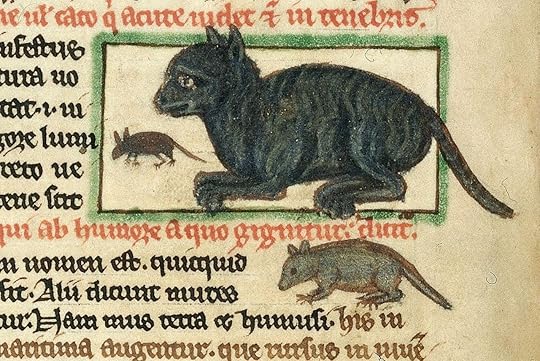
The poem reveals the affection the poet has for his pet, so much that he’s given his animal a name, and he refers to his cat as “he” rather than “it.” “Pangur Ban” is also relevant to those of us who write and seek knowledge today. Do we not rejoice when we capture that elusive piece of information we’ve been stalking? Are we not so proud we want to meow and drop the prey at our companion’s feet, I mean show it off?
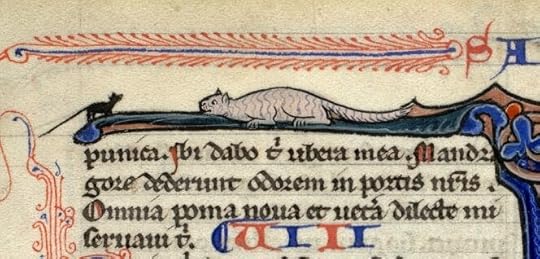
This delightful poem shows a universality in affection for our pets and the pure joy of learning. In many ways, we’ve not changed much from our ancestors, but in this case, it’s a good thing. Kim RendfeldKim Rendfeld is a cat lover and the author of The Cross and the Dragon (2012, Fireship Press), a tale of love amid wars and blood feuds, and The Ashes of Heaven’s Pillar(August 28, 2014, Fireship Press), a story of the lengths a mother will go to protect her children. To read the first chapters of either novel or learn more about Kim, visit kimrendfeld.com. You’re also welcome to visit her blog Outtakes of a Historical Novelist at kimrendfeld.wordpress.com, like her on Facebook at facebook.com/authorkimrendfeld, or follow her on Twitter at @kimrendfeld, or contact her at kim [at] kimrendfeld [dot] com.
Kim RendfeldKim Rendfeld is a cat lover and the author of The Cross and the Dragon (2012, Fireship Press), a tale of love amid wars and blood feuds, and The Ashes of Heaven’s Pillar(August 28, 2014, Fireship Press), a story of the lengths a mother will go to protect her children. To read the first chapters of either novel or learn more about Kim, visit kimrendfeld.com. You’re also welcome to visit her blog Outtakes of a Historical Novelist at kimrendfeld.wordpress.com, like her on Facebook at facebook.com/authorkimrendfeld, or follow her on Twitter at @kimrendfeld, or contact her at kim [at] kimrendfeld [dot] com.
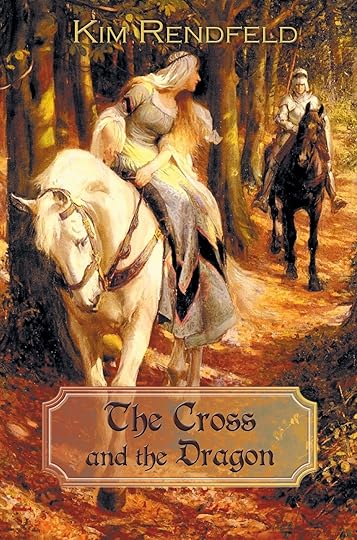
Thank you, Kim! OK, this isn't strictly relevant but I'm going to post it anyway! A quick sketch by my son of Widget, my writer's cat. Isn't she gorgeous? Look at that smile.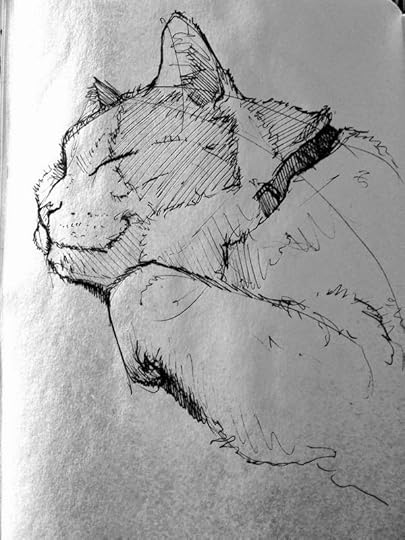 Widget - biro on paper :-)
Widget - biro on paper :-)
 The delightfully titled "Katzen und Maeuses"When you read about early medieval times, you expect war and brutal justice, not a charming poem about a cat. But such a thing does exists, and it was a pleasant surprise in my research for my novels. I stumbled across “Pangur Ban” in Pierre Riche’s Daily Life in the World of Charlemagne. Written in the margins of a manuscript found in a monastery in today’s Austria, this ninth-century piece is about a cat named Pangur Ban, written by an Irish monk. In the poem, the author compares his hunt for knowledge to the cat’s hunt for mice and describes the satisfaction both get from their arts. (A kind soul has posted two translations of the poem at http://homepages.wmich.edu/~cooneys/poems/pangur.ban.html .)
The delightfully titled "Katzen und Maeuses"When you read about early medieval times, you expect war and brutal justice, not a charming poem about a cat. But such a thing does exists, and it was a pleasant surprise in my research for my novels. I stumbled across “Pangur Ban” in Pierre Riche’s Daily Life in the World of Charlemagne. Written in the margins of a manuscript found in a monastery in today’s Austria, this ninth-century piece is about a cat named Pangur Ban, written by an Irish monk. In the poem, the author compares his hunt for knowledge to the cat’s hunt for mice and describes the satisfaction both get from their arts. (A kind soul has posted two translations of the poem at http://homepages.wmich.edu/~cooneys/poems/pangur.ban.html .)
The poem reveals the affection the poet has for his pet, so much that he’s given his animal a name, and he refers to his cat as “he” rather than “it.” “Pangur Ban” is also relevant to those of us who write and seek knowledge today. Do we not rejoice when we capture that elusive piece of information we’ve been stalking? Are we not so proud we want to meow and drop the prey at our companion’s feet, I mean show it off?

This delightful poem shows a universality in affection for our pets and the pure joy of learning. In many ways, we’ve not changed much from our ancestors, but in this case, it’s a good thing.
 Kim RendfeldKim Rendfeld is a cat lover and the author of The Cross and the Dragon (2012, Fireship Press), a tale of love amid wars and blood feuds, and The Ashes of Heaven’s Pillar(August 28, 2014, Fireship Press), a story of the lengths a mother will go to protect her children. To read the first chapters of either novel or learn more about Kim, visit kimrendfeld.com. You’re also welcome to visit her blog Outtakes of a Historical Novelist at kimrendfeld.wordpress.com, like her on Facebook at facebook.com/authorkimrendfeld, or follow her on Twitter at @kimrendfeld, or contact her at kim [at] kimrendfeld [dot] com.
Kim RendfeldKim Rendfeld is a cat lover and the author of The Cross and the Dragon (2012, Fireship Press), a tale of love amid wars and blood feuds, and The Ashes of Heaven’s Pillar(August 28, 2014, Fireship Press), a story of the lengths a mother will go to protect her children. To read the first chapters of either novel or learn more about Kim, visit kimrendfeld.com. You’re also welcome to visit her blog Outtakes of a Historical Novelist at kimrendfeld.wordpress.com, like her on Facebook at facebook.com/authorkimrendfeld, or follow her on Twitter at @kimrendfeld, or contact her at kim [at] kimrendfeld [dot] com.
Thank you, Kim! OK, this isn't strictly relevant but I'm going to post it anyway! A quick sketch by my son of Widget, my writer's cat. Isn't she gorgeous? Look at that smile.
 Widget - biro on paper :-)
Widget - biro on paper :-)
Published on July 30, 2014 03:23
'Familiar Felines.'
Following on from last weeks Halloween posting, today's blog post looks at the unwanted image of cats as the witches familiar - from the Norse Goddess Freya to lonely women in the middle ages.
The full Following on from last weeks Halloween posting, today's blog post looks at the unwanted image of cats as the witches familiar - from the Norse Goddess Freya to lonely women in the middle ages.
The full post can found at:
http://graceelliot-author.blogspot.com
...more
The full Following on from last weeks Halloween posting, today's blog post looks at the unwanted image of cats as the witches familiar - from the Norse Goddess Freya to lonely women in the middle ages.
The full post can found at:
http://graceelliot-author.blogspot.com
...more
- Grace Elliot's profile
- 156 followers



